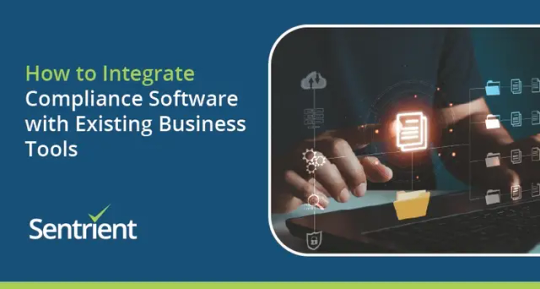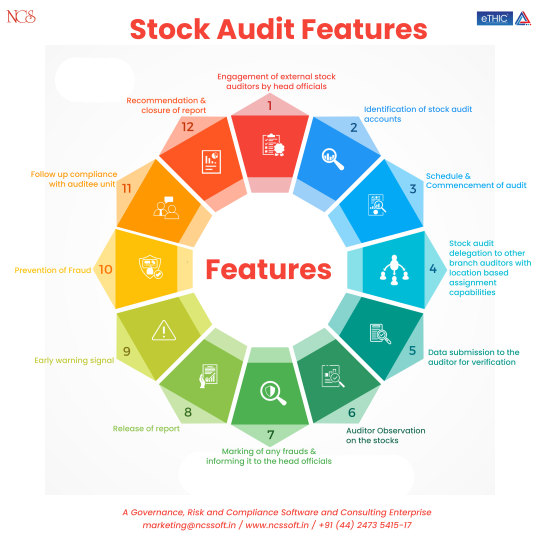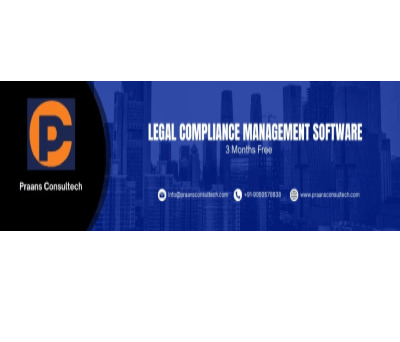#grc compliance software
Explore tagged Tumblr posts
Text
How to Integrate Compliance Software with Existing Business Tools

Integrating compliance software with your existing business tools isn’t just a technical upgrade – it’s a strategic move that can transform how your organisation manages risk and maintains regulatory standards. Modern businesses typically use 5-10 different software platforms daily, from CRM systems to accounting tools.
When you integrate compliance software effectively, you eliminate data silos and create seamless workflows that save time and reduce human error. Companies that successfully integrate compliance software with existing systems report up to 40% reduction in compliance-related administrative tasks.
At Sentrient, we’ve helped over 600 Australian businesses streamline their compliance processes through smart integration strategies. Whether you’re running a small team or managing a large organisation, the right integration approach can make compliance feel effortless rather than burdensome.
The key lies in understanding your current environment and choosing integration methods that complement, rather than complicate, your existing workflows.
What’s Your Current Business Software Setup?
1. Assess Your Current Digital Environment
Before you integrate compliance software, you need a clear picture of your existing digital environment. Most Australian businesses operate with a mix of core systems that handle different aspects of their operations.
2. Identify Your Core Business Tools
Your typical business toolkit likely includes customer relationship management (CRM) software, human resources information systems (HRMS), enterprise resource planning (ERP) platforms, and accounting software. Each system contains valuable data that could enhance your compliance management when properly connected.
3. Document All Software Platforms
Document every software platform your team currently uses, including cloud-based tools, desktop applications, and mobile apps. Note which systems store employee data, customer information, financial records, and operational metrics.
4. Map Current Data Flow
Understanding data flow between these systems is crucial. Where does information currently move manually between platforms? These manual touchpoints represent opportunities for automation through compliance software integration.
Important Things to Consider Before Integration
1. Data Security Priority
Data security must be your top priority when planning any integration. Compliance software handles sensitive information about your business operations, employee records, and regulatory requirements. Ensure any integration maintains or enhances your current security standards.
2. Industry-Specific Compliance Requirements
Compliance requirements vary significantly across Australian industries. Healthcare providers face different regulations than construction companies. Your integration strategy should align with industry-specific compliance frameworks that govern your business.
3. User Adoption Challenges
User adoption challenges can derail even the most technically sound integration. Consider how the integration will affect daily workflows for different team members. Will it simplify their tasks or create additional complexity?
4. Budget and Hidden Costs
Budget considerations extend beyond initial integration costs. Factor in ongoing maintenance, training requirements, and potential system upgrades. Hidden costs often emerge during the integration process if not properly planned.
5. Scalability Planning
Scalability planning ensures your integration grows with your business. Choose integration approaches that can accommodate new team members, additional compliance requirements, and evolving business processes without requiring complete overhauls.
Conclusion
Successfully integrating compliance software with existing business tools requires careful planning, gradual implementation, and ongoing attention to user needs. The investment in proper integration pays dividends through improved efficiency, reduced risk, and better regulatory compliance.
Sentrient’s integrated approach to HR, compliance, and GRC management demonstrates how thoughtful integration can transform business operations. Ready to explore how integration could streamline your compliance processes? Contact our team for a personalised consultation today.
#sentrient#compliance management system#hr management system#performance management#performance management system#compliance system#compliance management#grc software#manual handling training course#grc compliance software
0 notes
Text
Strategic Success: Unlocking Long-Term Sustainability with a Robust Governance, Risk, and Compliance Framework
In today’s rapidly evolving business landscape, organizations face an increasingly complex array of legal, operational, financial, and compliance risks. To navigate these challenges and achieve long-term success, a strategic approach known as Governance, Risk and Compliance (GRC) is essential. A robust GRC framework not only ensures adherence to laws, regulations, and industry standards but also…
View On WordPress
#business#Compliance#compliance and risk management#Governance#governance risk and compliance#governance risk management#GRC#grc framework#grc platform#grc risk management#grc software#grc tools#risk management#Security
1 note
·
View note
Text
Cybersecurity Glossary
Over the course of this year I have explained to colleagues and clients who’s roles are not in Cybersecurity what certain phrases or abbreviations mean. After I while I started to drop them into a word document so I could reuse them. Then I decided to make this post so I can easily share the explanations. There are bound to be things missing, please drop a comment if I have missed something and…
View On WordPress
#anonymisation#Attack Surface#authentication#BCP#Biometrics#Botnet#Compliance#Critical Infrastructure#cybersecurity#DDoS#DFIR#Embedded software#Encryption#Firewalls#GRC#ICS#IEC62443#Industrial Control System#IR#ISO27001#Malware#mfa#NIS2#Operational Technology#OSINT#OT#OT Security#PCI DSS#Penetration test#phishing
2 notes
·
View notes
Text
Understanding GRC Tool: A Comprehensive Guide for Financial Services
In today’s highly regulated and interconnected world, businesses across sectors like BFSI, SaaS, and FinTech face an unprecedented challenge: effectively managing governance, risk, and compliance (GRC). The sheer volume and complexity of these tasks — from adhering to industry-specific regulations to mitigating potential threats and ensuring operational audits can be overwhelming. This is precisely why GRC or governance risk and compliance software, isn’t just a convenience; it’s a critical necessity for survival and growth.
Why Choose GRC Audit Management Tool
Risk Management: GRC software provides tools for identifying, assessing, and mitigating risks. This is crucial for financial institutions that must manage various types of risks, including credit, market, and operational risks.
Compliance Management: Regulatory compliance management software helps organizations track and manage compliance obligations. This includes monitoring changes in regulations and ensuring that the organization adapts accordingly.
Audit Management: GRC internal audit software facilitates the planning, execution, and reporting of audits. This feature is essential for maintaining transparency and accountability within the organization.
Reporting and Analytics: Effective GRC tools offer robust reporting and analytics capabilities, allowing organizations to gain insights into their compliance status and risk exposure.
Integration: Many GRC solutions can integrate with existing systems, such as ERP and CRM platforms, to provide a seamless experience and enhance data accuracy.
One of the most significant benefits of implementing a dedicated GRC solution lies in its ability to streamline the audit process. For instance, GRC audit management tool automates many of the tasks traditionally associated with internal and external audits, from data collection and analysis to report generation. Specifically, GRC internal audit software empowers internal audit teams to conduct more thorough, efficient, and frequent assessments, identifying weaknesses before they escalate into significant issues. This proactive approach significantly reduces the time and resources typically consumed by audits, allowing businesses to focus on strategic initiatives.
The Role of Compliance Management Software
At its core, compliance management software is designed to simplify and automate compliance workflows. From policy documentation to audit tracking and regulatory updates, this software enables businesses to stay aligned with ever-changing regulations. Organizations can benefit significantly from a compliance management tool that:
Monitors and manages internal and external compliance requirements.
Automatically updates rules based on regional and global regulatory changes.
Generates reports to support audits and inspections.
Whether it’s data privacy regulations like GDPR, industry-specific standards like HIPAA, or financial regulations like Sarbanes-Oxley, the burden of proof for compliance rests squarely on the organization. A robust regulatory compliance software solution helps businesses track changes in regulations, map internal controls to specific requirements, and provide irrefutable evidence of adherence. This not only minimizes the risk of hefty fines and reputational damage but also fosters trust among stakeholders.
Beyond just regulations, effective compliance management software extends to internal policies and procedures. It ensures that employees are aware of and adhere to organizational guidelines, fostering a culture of accountability. The right compliance management tool can automate training, policy dissemination, and attestations, creating a verifiable audit trail that demonstrates an organization’s commitment to ethical conduct.
GRC tool eliminate the need for extensive on-premise infrastructure, allowing companies to quickly deploy and scale their compliance efforts. This accessibility is particularly beneficial for niche sectors with evolving regulatory demands.
In conclusion, the modern business environment demands a proactive and integrated approach to governance, risk, and compliance. From mitigating complex risks to ensuring seamless adherence to a myriad of regulations, GRC software is no longer a luxury but a fundamental component of a sustainable and successful enterprise. By embracing these powerful tools, organizations can transform GRC from a burdensome obligation into a strategic enabler, fostering resilience, building trust, and driving long-term value.
#grc software#grc tool#GRC audit software#grc internal audit software#governance risk and compliance software#regulatory compliance management software#regulatory compliance software#compliance management software#compliance management tool#saas compliance software#fintech compliance software#financial services compliance software#compliance software pricing#bank compliance software#compliance software for banks
0 notes
Text
Cloud Concinnity® 3.2.0 Enhances eClinical Trial Management Software The Cloud Concinnity® 3.2.0 release introduces advanced workflow customization, allowing administrators to streamline clinical trial processes with notification-only tasks and embedded eSignatures. This update improves survey distribution and ensures compliance with 21 CFR Part 11, providing a secure and efficient environment for clinical and regulatory teams.
#clinical trial oversight#clinical trials#grc tools#regulatory compliance#eClinical Trial Management Software#workflow customization#Cloud Concinnity
0 notes
Text
#compliance software#compliance management software#compliance solutions#governance risk and compliance#grc system
0 notes
Text
SAP Risk Management | SAP GRC RM | Governance Risk & Compliance | ToggleNow
At ToggleNow, we understand that exhaustive lists of risks can overwhelm and often become irrelevant, leading to inefficiencies. Our approach emphasizes focusing on value and core business activities in risk management. We believe that prioritizing risks impacting value and business performance is crucial, even if it means concentrating on a smaller yet more impactful segment of the business.

Our commitment lies in streamlining risk management efforts by leveraging SAP Risk Management. This comprehensive solution fosters collaboration and ensures consistency throughout your organization. We empower businesses to navigate risks effectively while concentrating efforts where risk managers can make the most significant contributions.
Read more: https://togglenow.com/services/sap-risk-management/
#Audit Management System#SAP Risk Management#SAP Risk Management Tool#SAP Risk Management services#SAP Enterprise Risk Management#SAP Risk Management Software#SAP Governance Risk and Compliance#SAP GRC Solutions Provider
0 notes
Text
How BCP Failures Can Disrupt Business: Insights from Real Events

Every business needs a business continuity plan (BCP) to ensure recovery during unforeseen events like data breaches, system outages, and other disruptions. However, 70% of organizations lack a fully documented BCP, leading to major downtime and financial losses. Even those with BCPs often experience challenges, as highlighted by recent high-profile failures.
Key BCP Statistics
20% of businesses fail within the first year.
91% of organizations face network outages quarterly.
Power failures and unexpected disruptions cause 44% of data center outages.
Downtime from ransomware can last up to 24 days, costing enterprises as much as $9,000 per minute.
These figures underscore the importance of updating and testing BCPs regularly. Let’s examine three real-world events of BCP failures.
1. FAA Systems Outage (2023) In January 2023, the FAA suffered a nationwide flight disruption after contractors accidentally deleted files during a database update. The outage impacted thousands of flights, marking the biggest air traffic disruption since 9/11. The root cause was an outdated database and hardware, prompting the creation of a task force to prevent future mishaps.
2. Change Healthcare Cybersecurity Attack (2024) Change Healthcare, a UnitedHealth subsidiary, experienced a major ransomware attack due to the lack of multi-factor authentication. The breach led to a ransom of $22 million in Bitcoin and the theft of 4TB of patient data. This incident caused severe operational disruption in healthcare, delaying claims and leading to massive financial losses.
3. OVHcloud Data Center Fire (2021) In March 2021, a fire at OVHcloud’s data center in Strasbourg destroyed nearly 30,000 servers and disrupted millions of websites. The fire resulted from faulty power systems and poor fire prevention measures. The disaster sparked lawsuits and negatively impacted the cloud provider’s operations, though OVHcloud later recovered by going public.
These examples highlight the critical need for enterprises to have robust BCPs that include cybersecurity measures and regular system updates. Explore more on BCP and compliance solutions with iTech GRC.
Contact us today for more information!
0 notes
Text

Check out the Features of Stock Audit. For more details @ www.ncssoft.in
NCS #ncssoftsolutions #eTHICCAAM
Audit software with best comprehensive integrated solution #Audit management software with robust auditing standards
#stockaudit#features#Best insurance software for Audit#eTHIC insurance software in India#Best Audit software for banks#audit#auditsoftware#compliance#grc platform#seo audit
0 notes
Text
Importance of Internal Audits
Internal audits are essential for assessing an organization's operations, identifying risks, ensuring compliance with regulations, and improving overall efficiency. They provide insights into financial, operational, and compliance-related aspects of your business.
Why Use Software for Internal Audits?
Efficiency: Software automates many audit processes, reducing the time and effort required to conduct audits.
Accuracy: Manual audits can be error-prone. Audit software helps ensure accuracy in data collection and analysis.
Consistency: Software enforces consistent audit procedures and documentation across your organization.
Real-time Reporting: With audit software, you can generate real-time reports, making it easier to track progress and address issues promptly.
Data Security: Audit software enhances data security, protecting sensitive information from unauthorized access.
Top Software Solutions for Internal Audits
ACL GRC: ACL GRC offers a comprehensive solution for internal audits, including risk assessment, data analysis, and reporting. It's known for its user-friendly interface and robust analytics.
TeamMate+: TeamMate+ is a widely used audit management software that streamlines the entire audit process, from planning to reporting. It offers customizable templates and powerful reporting tools.
AuditBoard: AuditBoard is a cloud-based platform that provides tools for risk assessment, audit management, and compliance. Its user-friendly interface makes it accessible to auditors at all levels.
Wolters Kluwer TeamMate Analytics: This software focuses on data analytics, helping auditors identify trends and anomalies in data. It integrates seamlessly with other audit management systems.
SAP Audit Management: If your organization uses SAP, their Audit Management software is a natural choice. It offers a unified platform for audit planning, execution, and reporting.
Conclusion
In today's fast-paced business environment, efficient and accurate internal audits are crucial for staying competitive and compliant. Investing in audit software can streamline your audit processes, improve accuracy, and provide valuable insights for decision-making. Evaluate your organization's needs and explore the options mentioned above to find the best software for doing internal audits that align with your goals and objectives.
For more details - https://m2iconsulting.com/blog-detail.php?name=Software%20for%20Doing%20Internal%20Audit&id=64
2 notes
·
View notes
Text
Governance, Compliance And Risk Software Market
Governance, Compliance And Risk Software Market is estimated to reach $38390.01 Million by 2030, growing at a CAGR of 12.00% During 2024 to 2030.
Governance, Risk, and Compliance (GRC) software market is witnessing robust growth as organizations across industries face increasing regulatory scrutiny, cybersecurity threats, and the need for transparent operations. Valued at $15.7 billion in 2024, the GRC software market is projected to grow at a CAGR of 11.2%, reaching over $33 billion by 2031. This growth is fueled by rising data privacy concerns, stringent government regulations, and the growing complexity of enterprise risk landscapes.
GRC software provides a unified platform to manage an organization’s policies, compliance requirements, risk assessments, and audit processes. By integrating governance, risk management, and compliance into a single framework, GRC tools help streamline operations, reduce redundancies, ensure accountability, and enhance decision-making across departments.
🔗 𝐆𝐞𝐭 𝐑𝐎𝐈-𝐟𝐨𝐜𝐮𝐬𝐞𝐝 𝐢𝐧𝐬𝐢𝐠𝐡𝐭𝐬 𝐟𝐨𝐫 𝟐𝟎𝟐𝟓-𝟐𝟎𝟑𝟏 → 𝐃𝐨𝐰𝐧𝐥𝐨𝐚𝐝 𝐍𝐨𝐰
The regulatory environment has become increasingly complex, particularly in sectors such as financial services, healthcare, energy, and manufacturing. Laws like GDPR, HIPAA, SOX, and evolving ESG reporting mandates are prompting enterprises to invest in scalable GRC solutions to avoid penalties and reputational damage. Automated compliance tracking, real-time risk analytics, and policy enforcement are key features enabling businesses to maintain adherence and agility.
Cybersecurity risks are another major driver accelerating GRC software adoption. With the rise in cyberattacks, ransomware, and data breaches, organizations are leveraging GRC platforms to assess IT risks, manage vulnerabilities, and align cybersecurity protocols with industry standards such as ISO 27001 and NIST.
Cloud-based GRC solutions are rapidly gaining popularity due to their scalability, ease of deployment, and cost-effectiveness. These platforms enable remote accessibility and integrate seamlessly with existing enterprise systems, offering centralized dashboards, risk heatmaps, and audit trails for proactive risk management.
Leading GRC software vendors include SAP, IBM, MetricStream, NAVEX Global, RSA Archer, and LogicManager. These companies are innovating with AI and machine learning to automate risk identification, enhance predictive analytics, and enable real-time compliance reporting.
However, the market faces challenges such as integration complexity, high initial costs, and organizational resistance to change. Many enterprises also struggle with fragmented data and siloed risk functions, necessitating a more cohesive GRC approach.

0 notes
Text
New Employee Induction Checklist: Everything You Need to Include

It has been reported that a comprehensive new employee induction checklist reduces turnover by 82% and increases productivity by 70% within the first 90 days. Poor onboarding costs Australian businesses an average of $18,000 per failed hire, whilst effective induction programs deliver a positive return on investment.
The psychology behind first impressions reveals that employees form lasting opinions about their workplace within the first week. These initial experiences directly impact long-term engagement, performance, and retention rates across all industries.
This comprehensive guide provides everything you need to create an effective employee induction framework. From pre-boarding preparation to 90-day integration milestones, we’ll cover the essential elements that transform new hires into productive, engaged team members.
Sentrient’s HR management solutions help Australian businesses streamline these processes with automated workflows and compliance-ready templates.
New Employee Induction Checklist
Pre-Boarding (1 Week Before)
Set up workspace with computer, equipment, and supplies
Create user accounts, email, and system access
Prepare welcome package with handbook and company materials
Schedule first-day activities and assign buddy/mentor
Day One Essentials
Conduct welcome meeting and office tour
Complete employment contracts and legal documentation
Set up IT systems, login credentials, and communication tools
Provide workplace health and safety briefing
Introduction to team members and key personnel
First Week Foundation
Share company culture, mission, and values
Begin role-specific training modules
Train on communication and collaboration tools
Conduct daily check-ins and progress assessments
Month One Integration
Complete comprehensive role training and assessments
Introduction to other departments and key stakeholders
Assign initial projects with clear expectations
Conduct 30-day review and feedback session
90-Day Milestone
Complete performance evaluation covering skills and cultural fit
Assess integration success and productivity metrics
Set long-term career objectives and development plans
Determine probation outcomes and permanent arrangements
Digital & Remote Considerations
Configure essential systems, security settings, and mobile access
Set up virtual workspace and communication protocols (for remote staff)
Provide cybersecurity training and compliance requirements
Legal & Compliance
Verify work rights and collect tax/superannuation details
Complete mandatory WHS and industry-specific training
Ensure all documentation is signed and securely stored
Success Tracking
Monitor training completion and productivity milestones
Collect feedback at 30, 60, and 90-day intervals
Track retention rates and calculate ROI
Conclusion
A comprehensive new employee induction checklist transforms first-day nerves into confident productivity. From pre-boarding preparation through 90-day integration milestones, each element contributes to long-term success and retention.
The most effective programs combine structured processes with personalised support, ensuring every new hire feels welcomed, prepared, and valued. Technology integration streamlines administrative tasks whilst maintaining the human connections that drive engagement.
Sentrient’s integrated HR management solutions help Australian businesses implement these strategies effortlessly. Our automated workflows, compliance-ready templates, and mobile-friendly platforms ensure consistent, engaging induction experiences that drive results.
Ready to transform your employee induction process? Discover how Sentrient’s innovative HR technology can help your organisation implement these best practices efficiently whilst ensuring compliance with Australian workplace requirements.
Take action today: Partner with Sentrient for seamless, automated employee onboarding solutions that save time, improve retention, and create lasting positive impressions from day one.
#sentrient#compliance management system#hr management system#performance management#performance management system#compliance system#compliance management#grc software#manual handling training course#grc compliance software
0 notes
Text
Why Every Organization Needs a Governance, Risk & Compliance Solution
In today’s complex business environment, organizations are under increasing pressure to meet legal obligations, manage risks effectively, and operate with transparency and accountability. Governance, Risk, and Compliance (GRC) is an integrated framework that helps businesses address these challenges in a unified and strategic manner. Rather than treating governance, risk management, and…
#business#Business Intelligence#compliance software#enterprise governance#Governance#governance risk and compliance#governance risk and compliance platforms#GRC#grc platform#grc risk management software#grc software#Information Technology#policy management#Regulatory Compliance#Risk and Compliance#risk and compliance software#risk compliance software#risk management#Security#technology
0 notes
Text
Praans Consultech GRC Software – Streamlined Legal Compliance Management

Ensure seamless legal compliance with Praans Consultech’s GRC software—manage audits, risks, and statutory regulations effortlessly with real-time tracking and automation.
0 notes
Text
Audit Management Software for BFSI: Simplify Compliance and Risk Management
In the rapidly evolving landscape of financial services, the audit management process is crucial for streamlining internal audits, ensuring regulatory compliance, and reducing risk. Traditional auditing methods that rely on spreadsheets and manual documentation often cause delays, lead to errors, and offer limited visibility into the audit process. Without automation, sometimes it becomes challenging to track changes, ensure data integrity, and respond swiftly to GRC or Governance Risk and Compliance audits or internal reviews.
This highlights the urgent need for a modern, technology-driven internal audit management system that can centralize audit activities, improve accuracy, and enhance transparency. By automating internal tasks such as audit planning, scheduling, execution, documentation, and reporting, internal audit software systems empower BFSI, SaaS, Fintech, and other industries to work more efficiently and make informed decisions.

GRC internal audit software systems offer real-time dashboards, risk assessment tools, and built-in compliance frameworks that enable organizations to stay ahead of regulatory compliance requirements while ensuring RBI, ISO, SOC 2, and HIPAA compliance. Choosing a cloud-based audit software not only saves time and resources but also strengthens governance and boosts overall organizational resilience in today’s complex banking and financial environment.
Why Choose Audit Management Software for BFSI?
Audit Workflow Automation: Audit software automates the entire audit process, from task management to findings tracking and audit scheduling. This automation not only saves time but also minimizes human error, ensuring a more reliable audit process. With a centralized platform, teams can manage all audit-related tasks efficiently, leading to improved productivity and faster audit cycles.
Regulatory Compliance Monitoring: Audit software helps financial institutions comply with various regulatory requirements, including those set by the Reserve Bank of India (RBI), Securities and Exchange Board of India (SEBI), Insurance Regulatory and Development Authority of India (IRDAI), Sarbanes-Oxley Act (SOX), and Basel III. Audit management software provides tools for ongoing compliance monitoring, ensuring that institutions remain audit-ready at all times.
Real-Time Reporting & Dashboards: The Audit tool offers real-time reporting capabilities that allow users to visualize audit progress, findings, and compliance gaps. This feature enables teams to make informed decisions quickly. Users can create dashboards tailored to their specific needs, providing insights that are crucial for effective audit management.
Risk & Issue Management: Internal audit software allows teams to flag issues and track remediation efforts, reducing regulatory exposure and enhancing overall risk management. The software integrates risk assessment tools that help identify potential compliance risks before they escalate.
Collaboration & Document Control: Audit Tools facilitates collaboration across various departments, ensuring that all stakeholders are involved in the audit process. Audit software provides role-based access to audit documents, ensuring that sensitive information is protected while still being accessible to authorized personnel.
Faster Audit Closure: By automating compliance tasks, internal audit management software can reduce the time spent on audits by up to 60%. This efficiency allows teams to focus on more strategic initiatives rather than getting bogged down in administrative tasks.
Audit Management Software Free Demo
AuditWise audit software stands out as a leading governance risk and compliance or grc internal audit management software for various institutions. Its robust features, including workflow automation, compliance monitoring, real-time reporting, audit scheduling, and risk management, make it an invaluable tool for banks, NBFCs, fintechs, and insurance firms. By choosing AuditWise, organizations can streamline their audit processes, achieve compliance, and reduce risk, ultimately leading to more efficient and effective internal audit management.
Explore audit management software for banks and other financial institutions with a free trial. No credit card is required. Experience powerful features, transparent pricing, and enterprise-grade security — all in one platform.
#audit software#internal audit management software#audit management software#cloud based audit software#software internal audit#nbfc audit#bfsi audit#audit management software for banks#audit software for banks#internal audit software for banks#grc software#grc tool#governance risk and compliance software#audit management software pricing#audit software for BFSI#audit software for ndfc#audit software for financial Institutions
0 notes
Text
Cloud Concinnity® – Streamlined GRC & Compliance Software
Enhance governance, risk, and compliance (GRC) management with Cloud Concinnity®. Our all-in-one platform integrates process automation, team collaboration, and compliance tracking for seamless decision-making and regulatory adherence.
#clinical trial oversight#clinical trials#grc tools#Compliance Software#GRC Management#Clinical Trail Oversight Software#Clinical Trail Management#artificial intelligence
0 notes